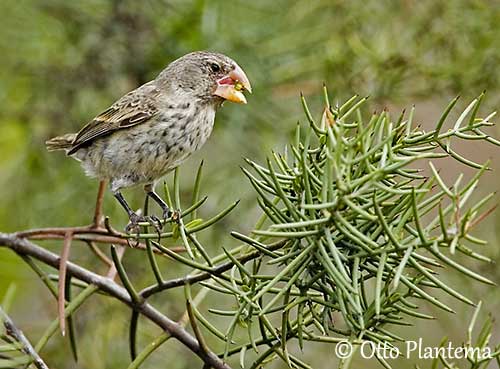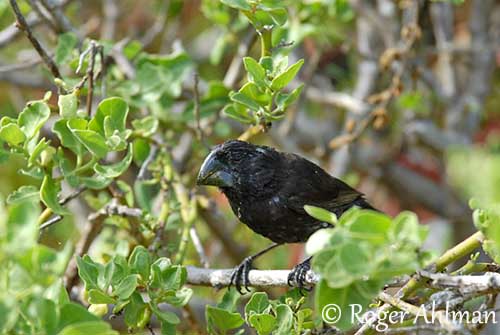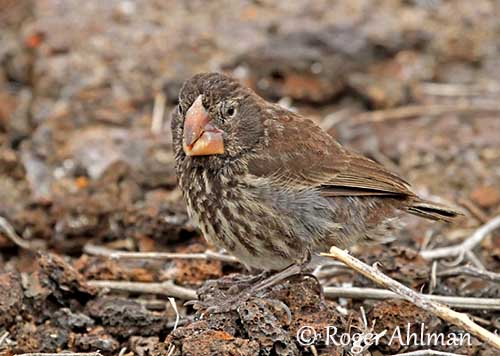
Fr: Géospize à gros bec
All: Großgrundfink
Esp: Pinzón de Darwin Picogordo
Ita: Fringuello terricolo grosso
Nd: Grote Grondvink
Sd: Tjocknäbbad markfink
Photographers:
Roger Ahlman
Pbase Galleries Peru and Ecuador
Otto Plantema
Trips around the world
Illustration:
John Gould: 1804-1881
Illustration's Origin: Darwin, C. R. ed. 1839. Birds Part 3 No. 4 of The zoology of the voyage of H.M.S. Beagle. by John Gould. Edited and superintended by Charles Darwin. London: Smith Elder and Co.
Sources:
HANDBOOK OF THE BIRDS OF THE WORLD Vol 16 by Josep del Hoyo- Andrew Elliot-David Christie – Lynx Edicions – ISBN: 9788496553781
L’ENCYCLOPEDIE MONDIALE DES OISEAUX - Dr Christopher M. Perrins - BORDAS - ISBN: 2040185607
BirdLife International (BirdLife International)
Neotropical Birds – Cornell Lab of Ornithology
Large Ground-Finch
Geospiza magnirostris
Passeriformes Order – Thraupidae Family
Darwin’s Finches - Generalities
INTRODUCTION:
The Large Ground-Finch is endemic to the Galapagos Islands. It is the largest of all the Darwin’s Finches. Its large beak allows it to feed on the largest available seeds and large insects. The bill shape also involves slower and lower-pitched sounds and more nasal calls. It is usually found in arid lowland areas.
DESCRIPTION OF THE BIRDS:
Biometrics:
Length: 15-16 cm
Weight: 27-39 g
The adult male is almost entirely black, except the slightly browner wings and tail, and the white streaked black vent. The tail is relatively short.
The massive bill has thick base of lower mandible and curved culmen. Like in other males’ finches, the bill is black during the breeding season, turning orange-yellow outside this period. The eyes are dark brown. Legs and feet are blackish.
The female has dark brown plumage with pale buff to grey fringing, involving scaled pattern on the upperparts. Head and breast are streaked, with the dark streaks becoming paler on lower breast, and less distinct on belly and undertail-coverts.
Some birds are darker, rather hooded, with more uniform dark head sides.
The bill’s colour varies according to the breeding state, from dark with orange base and yellow tip, to entirely orange-yellow.
The immature male is intermediate between male and female, with blacker head and breast, diffuse streaking on back and belly, and blackish wings.
RANGE:
The Large Ground-Finch occurs on several Galapagos Islands such as Pinta, Marchena, Genovesa, Fernandina, Isabela, Santiago, Rábida, Pinzón, Baltra, Santa Cruz and Santa Fe.
HABITAT:
The Large Ground-Finch frequents arid scrubs in the lowland areas of each island.
CALLS AND SONGS: SOUNDS BY XENO-CANTO
The Large Ground-Finch’s voice differs from other finches due to bill structure and shape. Usually, the male sings only one song type, a nasal repetition of 2-3 notes “chzweee-chzwee” with lower-pitched sounds and slower speed than those of the Medium Ground-Finch. The call is a high-pitched “tzeeeeppp”.
BEHAVIOUR IN THE WILD:
The Large Ground-Finch feeds mainly on large seeds, and also takes Opuntia cactus fruits, caterpillars and large insects.
It feeds on seeds of Bursera graveolens, but its main food source includes the woody seeds of Tribulus cistoides. Its large, strong bill allows it to crack open these hard seeds. This species forages mainly on the ground.
Pairs are usually monogamous. A small territory is maintained and the nest is built within this area. Competition for food is intense during the breeding season, but the large bill of this species allows the Large Ground-Finch to take different seeds and food items.
The male builds several nests before to display outside one of them in front of a female. Once the pair is formed, the female usually completes one of the nests or builds a new one herself.
The Large Ground-Finch is resident, and only performs short flights within its range.
REPRODUCTION OF THIS SPECIES:
The breeding season starts soon after the first rains, and the peak of laying occurs during high rainfalls, when there are abundant food resources.
The nest is a spherical structure with lateral entrance towards the top. It is placed in bush or more often in cactus, between one and nine metres above the ground. It is made with twigs, dry grasses and lichens.
The female lays 4 whitish eggs with darker spots. The incubation lasts about 12 days. The chicks fledge 13-15 days after hatching. They are fed mainly with insects.
PROTECTION / THREATS / STATUS:
The Large Ground-Finch is common and widespread in its range. Its populations appear stable, but the species is extinct on Floreana Island.
Although living in restricted range, the Large Ground-Finch is not currently threatened.



